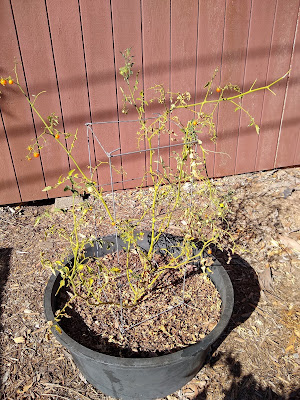Tomato problems widespread this summer
 |
This Sungold plant is history. (Photo courtesy DRWWilson) |
By Debbie Arrington
Call it Sungold sudden death syndrome. Several gardeners in the greater Sacramento area reported the loss of their super-sweet yellow cherry tomato plants in July – just when tomatoes are supposed to be hitting their stride.
Placer County master gardener Pauline Sakai first brought this situation to our attention. After a call to readers to share their experiences, we quickly discovered Pauline’s dead Sungold was not alone. We received more than 50 replies. And Sungolds weren’t the only variety having issues.
“Wow! I was so relieved to hear I’m not the only one in Sac with terrible tomato luck this summer,” wrote reader Enid Pritikin. “BOTH our Sungolds and our Early Girls were total flops.”
“After the most prolific production I can ever remember, (the Sungolds) stopped and are dying,” wrote Martin Miller of Elk Grove.
“My Sungold tomatoes look like they are in stress,” wrote Michele Chouinard. “Only a couple of tomatoes right now and the leaves are turning yellow brown.”
“DRWWilson” submitted a photo of a very sad Sungold with this note: “I planted this Sungold in April, and it did well until about June, when it ran out of steam. Now it's just about done. I never got much of a crop. My other tomatoes are fine, and I am an experienced grower and a Master Gardener. I too thought it was only me.”
Readers purchased their transplants from several sources including just about every nursery in the greater Sacramento area. Some grew their plants from seed.
The common denominator? Weather. We all experienced similar hot, dry, windy conditions in early and midsummer. Those conditions brought about heat stress – and the plants could only take so much.
Sungold may be more sensitive to heat stress than other varieties.
Farmer Fred Hoffman, the popular Sacramento radio host and lifetime master gardener, had a similar problem with a Sungold last year. “It was in full sun and it got too much heat,” he said. That plant also got reflective heat from a nearby driveway.
“This year, I planted it where it gets six hours of sun and it’s a happy camper,” he added.
Most likely, those hot weather issues “cooked” our Sungolds and cut their lifespans short.
 |
This is Pauline Sakai's sad Sungold. (Photo courtesy Pauline Sakai) |
Curly top – beet curly top virus – is spread by the beet leafhopper, which overwinters in the foothills and descends on the Central Valley in spring. Tomatoes have no resistance to curly top and can become infected by leafhoppers feeding on their stems.
“Plants with curly top are stunted because growth ceases,” according to the UC IPM tomato pest management guidelines. “Plants turn yellow to bronze with purple-tinged leaves. Plants become stiff and soon die. Green fruit turns red (or yellow in Sungold’s case), regardless of age.”
Another possibility: Tomato yellow leaf curl. Spread by a whitefly, this virus was first discovered in California in 2007 and has slowly crept into the Central Valley. It hasn’t been a problem in past years because our winters were cold enough to kill these whiteflies. As long as there’s a period with no tomato plants, this virus was kept away.
But we had a very mild winter in 2019-20. Many tomato plants survived those colder months – and so possibly did whiteflies carrying this virus.
Symptoms of this virus: Plants become stunted and bushy. Flowers fail to develop properly and fall off. Leaves are small and curl upwards.
“Tomato yellow leaf curl virus is undoubtedly one of the most damaging pathogens of tomato, and it limits production of tomato in many tropical and subtropical areas of the world,” according to the UC IPM website. “It is also a problem in many countries that have a Mediterranean climate such as California. Thus, the spread of the virus throughout California must be considered as a serious potential threat to the tomato industry.”
UC Davis researchers are on the lookout for this disease. If you suspect tomato yellow leaf curl, contact Robert L. Gilbertson at UCD. rlgilbertson@ucdavis.edu.
Fusarium wilt is another suspect. It attacks the plant’s vascular system, usually one side before the other. It was originally ruled out of the Sungold deaths because that variety has Fusarium wilt resistance. But not all Fusarium wilt strains are the same. Sungold has resistance to the two most common strains, but not all.
To determine if a plant succumbed to Fusarium wilt, look at the stem. “You need to do a postmortem,” Hoffman said. “Take a cross-section of the stem (near the base). Fusarium wilt leaves telltale dark reddish stains; the inside of the stem is not ivory.”
If it’s ivory? Then likely it was the weather after all.
For more advice on growing tomatoes in the Central Valley and disease management, check out the UC IPM tomato guidelines: https://www2.ipm.ucanr.edu/agriculture/tomato/


Comments
Post a Comment